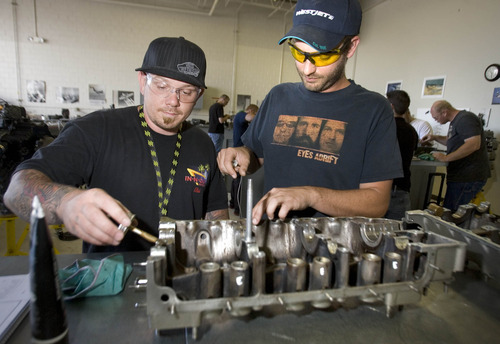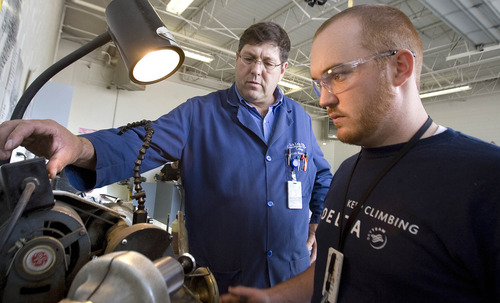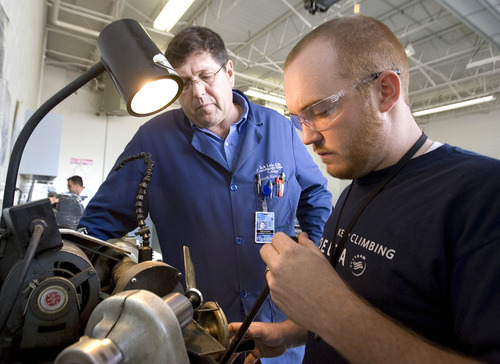This is an archived article that was published on sltrib.com in 2013, and information in the article may be outdated. It is provided only for personal research purposes and may not be reprinted.
Talk about the future of Utah's economy and sooner or later someone will bring up the need for more "STEM"-educated college graduates.
STEM is short for science, technology, engineering and math and these days it is all the rage among Utah educators and policy makers.
Convinced that having large numbers of workers with degrees in STEM fields will play a direct role in driving the state's economic growth in the decades ahead, the Utah Legislature earlier this year set aside $10 million for the formation of a new center dedicated to improving Utah education in those areas.
"If we're going to give our children and our youth the skills to be competitive in the global economy, we've got to make sure they have math and science backgrounds," Rep. Val Peterson, R-Orem, said earlier this year in introducing the legislation establishing the STEM center.
Yet a new report by the Brookings Institution suggests states that hope to encourage large numbers of college graduates to pursue STEM degrees need a broader perspective.
"There are really two STEM economies," said Jonathan Rothwell, who authored the Brookings report titled "The Hidden STEM Economy."
He explained there is a professional STEM economy linked to college and graduate school education. Closely allied with the corporate sector, it plays a vital function in keeping businesses on the cutting edge of technological development.
Often overlooked, though, is a second STEM economy that draws upon high school graduates, vocational schools and community colleges, he said. "Those workers are less likely to be directly involved in invention but they are critical to the implementation of new ideas and often advise researchers on the practical aspects of technological development.
Rothwell pointed out that half of all STEM jobs are available to workers without a four-year college degree, and those jobs pay $53,000 a year on average, or about 10 percent more than jobs with similar educational requirements.
Yet often, those jobs are looked down upon even though they are just as critical to the functioning of a well-oiled, high-tech economy.
"We see it all the time. A lot of people, including many high school guidance counselors, think that the jobs in the skilled trades are for students who lack motivation and are not as bright as those headed to college," said Will Nickell, assistant training director at the Utah Career Center, which trains pipefitters, plumbers and heating and ventilation and air conditioning technicians. "That is just not the case."
Learning to be a pipefitter who can install medical gas systems in hospitals and clinics or a HVAC technician who works building clean rooms for computer chip manufacturers requires an extensive knowledge of math and science, he said.
"I'll often stand before a class and ask the students 'How many of you hated math in high school?' and a lot of them will raise their hands. And then I'll tell them that they've just chosen a career where they will be using math every day. But if they're willing to apply themselves then we'll get through it," Nickell said.
Todd Baird, who oversees the aviation maintenance program at Salt Lake Community College, said students who graduate from that program and are certified to work on fixed-wing and rotor-wing aircraft that use reciprocating and turbine engines have a high degree of science and technical training.
"They have to understand advanced hydraulics, electronic flight controls, sheet metal and composite work," he said. "And what is ironic is that the federal government describes their work as 'unskilled labor' because they don't have a category for what they do."
State science advisor Carol George, who is overseeing the establishment of the STEM center, said much of the center's initial focus will be on improving math education in the sixth through eighth grades.
"This is an initiative that will benefit students regardless of whether they pursue a college degree or take another educational path," George said.
Richard Nelson, president and chief executive of the Utah Technology Council, agreed it is important the state give equal emphasis to all post-secondary educational opportunities.
"If we just concentrate on encouraging students to get bachelor through Ph.D. degrees then we'll be missing out because there are tremendous opportunities and a lot of demand for workers skilled in applied technology," he said.
Twitter: OberbeckBiz







